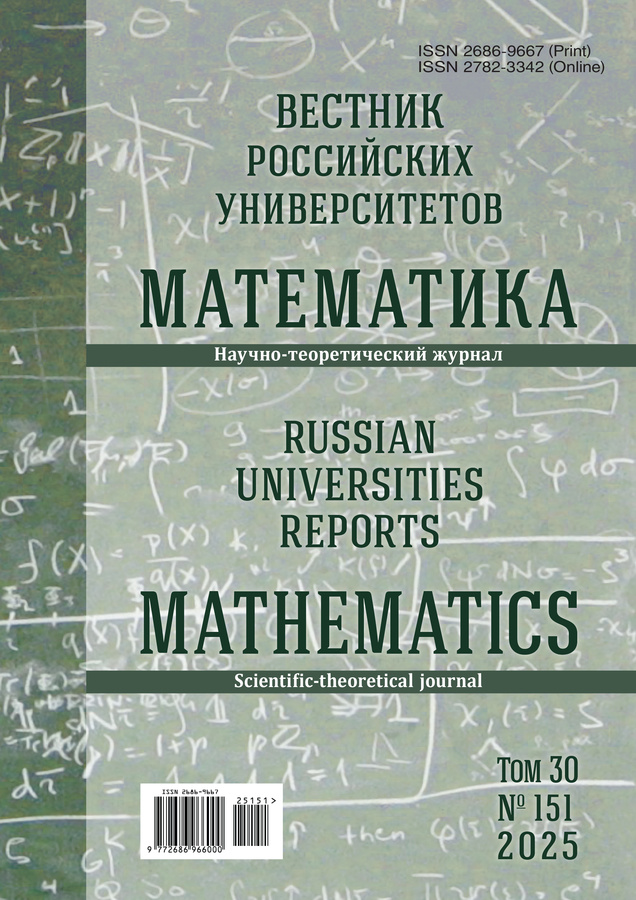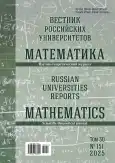Russian Universities Reports. Mathematics
Journal “Russian Universities Reports. Mathematics” is a peer-reviewed scientific and theoretical journal, where articles on mathematics and its applications with new mathematical results and reviews highlighting modern condition of current problems of mathematics are published. The journal is intended for a wide range of specialists in the field of mathematics, as well as for research scholars and students applying mathematical methods in the natural sciences, technics, economics, humanities.
The main scopes of the journal are: prompt publication of new original mathematical results of theoretical and applied importance; informing about the directions of research in various branches of mathematics, about modern mathematical problems; promoting the development of applications of mathematical methods and results.
It is published since June 14, 1996. Until May 27, 2019, the journal was published under the name “Tambov University Reports. Series: Natural and Technical Sciences” (ISSN 1810-0198).
The establisher, publisher, editorial office of the journal is FSBEI of HE “Derzhavin Tambov State University” (33 Internatsionalnaya St., Tambov 392000, Tambov Region, Russian Federation, tel. +7(4752)72-34-40, e-mail: post@tsutmb.ru).
The publication is registered by the Federal Service for Supervision of Communications, Information Technology and Mass Media (Roskomnadzor), extract from the register of registered mass media (register entry dated July 3, 2019 ПИ no. ФС77-76133).
ISSN 2686-9667 (Print). ISSN 2782-3342 (Online).
The journal is a member of the partnership: “Committee on the Ethics of Scientific Publications” and the professional community “Association of Science Editors and Publishers (ASEP)”, CrossRef (DOI of the journal: 10.20310/2686-9667).
Publication frequency is 4 issues per year (March, June, September, December).
Edition is 1000 copies.
Distribution territory of the journal: Russian Federation and foreign countries. The journal is distributed through subscription, at conferences, exhibitions, in the editorial office and partner universities.
General instruction on formation and publishing the scientific and theoretical journal is implemented by the editorial board with the editor-in-chief.
Editor-in-chief of the journal – Doctor of Physics and Mathematics, Professor, Director of Research Institute of Mathematics, Physics and Informatics of Derzhavin Tambov State University Evgeny Semenovich Zhukovskiy.
Themes of the journal. The journal publishes articles on various areas and branches of mathematics (algebra and logic, geometry and topology, functional analysis, differential equations, optimization and control, probability theory and mathematical statistics, computational methods, etc.), its applications.
Scientific works are published in three main types:
– review articles reflecting the current state of research in a certain mathematical direction;
– original articles describing the results of the research of specific mathematical problems, containing complete proofs of the results obtained by the author;
– short messages which present the results of the research of specific mathematical problems, containing precise formulations without complete proofs.
The journal also publishes the proceedings of mathematical conferences organized by the university, pee-reviews, personalia and informational materials about mathematical life of the university.
The authors of the journal are Russian and foreign scholars. Editorial office accepts manuscripts in Russian or English languages.
It is possible to get acquainted with the requirements to the arrangement of the materials in the sections “Rules of scientific articles sending, reviewing and publishing” and “Rules for authors”.
Publications in journal are made on non-commercial basis. The editorial office does not take payment from the authors for preparation, placement and printing of materials.
Indexing
The journal is indexed in the database of the Russian Science Citation Index (RSCI), included in the RSCI core collection, indexed in the Russian Science Citation Index (RSCI) database on the Web of Science platform, Scopus.
The journal is included in the "White list", List of peer-reviewed scientific publications recommended by the Higher Attestation Commission (HAC) (Q1) – a group of scientific specialties according to the HAC Nomenclature: 01.01.00 – mathematics.
The journal is also included in Zentralblatt MATH (“Central Journal on Mathematics”) – reviewing mathematical journal established by the Publisher “Springer” and electronic database “ZBMATH – The database Zentralblatt MATH”; Norwegian Register of Scientific Journals, Series and First Level Publishers (NSD); Math-Net.Ru – all-Russian portal of scientific information on mathematics, physics, information technology and related sciences; Reviewing journal and Databases of VINITI of the Russian Academy of Sciences; the International database of Scientific Literature SciLIT; one of the biggest International bibliographic databases “Ulrich’s Periodicals Directory” of American publisher Bowker (containing and describing the world flow of periodicals in all thematic areas).
Free full-text network versions of the issues of scientific and theoretical journal “Russian Universities Reports. Mathematics”, abstracts and keywords for all scientific articles and reviews can be found in open access on Russian and English languages at platforms of Scientific Electronic Library eLIBRARY , Electronic Library “CyberLeninka” and on the All-Russian mathematical portal Math-Net.Ru.
Copyright
![]()
Authors retain the copyright without restrictions. When re-publishing materials, the author undertakes to give a reference to the previously published articles in the journal “Russian Universities Reports. Mathematics”.

“Russian Universities Reports. Mathematics” provides Open Access to full-text issues.
Plagiarism policy
In the editorial office of the journal “Russian Universities Reports. Mathematics” all articles submitted for consideration are checked in the Antiplagiat system.
Editorial office and publisher address: 33 Internatsionalnaya St., Tambov 392000, Tambov Region, Derzhavin Tambov State University
Contact telephone of editorial office: +7(4752)72-34-34 ext. 0440.
E-mail of editorial office: zukovskys@mail.ru; ilina@tsutmb.ru
Editorial board, Editor-in-Chief of the journal Dr. Prof. Evgeny S. Zhukovskiy.
Current Issue
Vol 30, No 151 (2025)
Original articles
Existence of a coincidence point in a critical case when the covering constant and the Lipschitz constant are equal
Abstract
We consider two mappings acting between metric spaces and such that one of them is covering and the other satisfies the enhanced Lipschitz property. It is assumed here that the covering constant and the Lipschitz constant of these mappings are equal. We prove the result of the existence of a coincidence point of single-valued mappings in the case when the series of iterations of the function that provides execution of the enhanced Lipschitz property converges. We prove the similar result for set-valued mappings. We provide examples of functions for which the series of their iterations converges or diverges.
 209-217
209-217


On sufficient conditions of the asymptotic stability for equilibria of difference equations
Abstract
The paper considers nonlinear autonomous first-order
difference systems in real finite-dimensional spaces. For these systems, we study
the asymptotic stability of equilibria. The classical sufficient conditions for asymptotic stability of an equilibrium for difference equation generated by a smooth mapping $f$
are as follows. If the spectral radius of the first derivative of the mapping $f$ at the given equilibrium point is strictly less than one, then this equilibrium point is asymptotically stable. In the present paper, new sufficient conditions for asymptotic stability of the equilibrium are given. The obtained conditions are also applicable to some mappings for which the spectral radius mentioned above is equal to one. These conditions are as follows. There exists a punctured neighborhood of the given equilibrium point such that the mapping defining the difference equation is locally contractive around each point of this neighborhood.
We present an example in which the spectral radius mentioned above equals one,
however, all the assumptions of the obtained stability theorem are fulfilled.
It is shown that the known stability sufficient conditions follow from the obtained results.
An important feature of our stability sufficient conditions is that they are applicable to difference equations generated by continuous non-smooth mappings.
 218-225
218-225


Some topological properties of $f$-quasimetric~spaces
Abstract
The properties of the $f$–quasimetric space $(X,\rho)$ are studied. In a space as such, the distance $\rho$ satisfies the identity axiom and the generalized triangle inequality: $\rho(x,z) \leq f(\rho(x,y),\rho(y,z))$ for any $x,y,z\in X.$ Here the function $f$ is positive for positive arguments, continuous at the point $(0,0)$, and $f(0,0)=0.$ The symmetry of the distance is not assumed. The topology on $X$ generated by the distance $\rho$ is defined in the standard way. The properties of convergent sequences and sequentially compact sets are studied. Conditions are obtained under which the convergence in itself (mutual convergence) is necessary for the convergence of a sequence. The relationship between the rates of convergence of a fundamental sequence and its convergence in itself is considered. The concept of a sequentially precompact set is introduced. Conditions are obtained under which the closure of a sequentially precompact set is sequentially compact.
 226-237
226-237


Estimates in the class of analytical functions related to the Cassini oval and some of their applications
Abstract
In this article, we introduce and study a class $\mathcal{P}_n(\varphi_\lambda)$ of functions $\varphi(z) = 1 + c_n z^{n} + c_{n+1} z^{n+1} + \ldots,$ $n\geq1,$ analytic in the open unit disk $E,$ subordinate to the function $\varphi_\lambda(z)=1+{(1-\lambda)z}/{(1-\lambda z^2)},$ $0\le\lambda<1.$ From a geometric point of view, this means that the set of values of the function $\varphi(z)$ is contained within the region $\varphi_\lambda(E)$ bounded by the Cassini oval.
The properties of the subordination majorant are investigated $\varphi_\lambda(z).$ Based on this, relying on the method of subordination of analytical functions, in the class $\mathcal{P}_n(\varphi_\lambda),$ precise estimates are established for $\mathrm{Re}\, \varphi(z),$ $\left|\varphi(z)\right|,$ and $\left|{z\varphi'(z)}/{\varphi(z)}\right|,$ leading to one of the classical results in a particular case.
The application of these estimates to the study of extreme properties of some classes of analytical functions $f(z)$ of the form $f(z) = z + a_{n+1}z^{n+1} + a_{n+2}z^{n+2} + \ldots,$ $n\geq 1$ is considered. In particular, theorems of growth, covering, and radii of convexity are established for one class of starlike functions which is constructed by using the function $\varphi_\lambda(z)$ and generalizes the well-known subclass of starlike functions of R.~Singh. Applications of the obtained results to the study of some classes of close-to-starlike and doubly close-to-starlike functions related to the function $\varphi_\lambda(z)$ are also given. In particular, in these classes, growth theorems are established and radii of starlikeness are found. All obtained results are accurate, represent new original results as well as some generalizations of known results.
 238-254
238-254


Problems of optimal periodic resource harvesting for population models described by difference equations
Abstract
We consider models of homogeneous or structured (by type, age, or other charac\-te\-ris\-tic) populations, the dynamics of which, in the absence of exploitation, is given by a system of difference equations
$x(k+1) = F\big(k, x(k)\big),$
where $x(k) = \big(x_1(k), \ldots, x_n(k)\big),$ $x_i(k),$\linebreak $i=1,\ldots,n$ is the amount of the $i$-th type or age class of the population at a time\linebreak $k=0,1,2,\ldots;$ $F(k,x)=\bigl(F_1(k,x), \ldots, F_n(k,x)\bigr),$ $F_i(k,x)$ are real functions that are defined and continuous on the set$\mathbb{R}^n_+ \doteq\big\{x\in\mathbb{R}^n : x_1\geqslant0, \ldots, x_n\geqslant0\big\}.$
It is assumed that at times $k=1, 2, \ldots$ the population is exposed to harvesting $u(k)=(u_1(k),\ldots,u_n(k))\in[0, 1]^n.$ Then the model of the exploited population is investigated, given by a system of difference equations
where $X(k)=\big(X_1(k),\ldots,X_n(k)\big),$ $(1-u(k))X(k)=\big((1-u_1(k))X_1(k),\ldots,(1-u_n(k))X_n(k)\big),$ $X_i(k)$ and
$(1-u_i(k))X_i(k)$ is the amount of the resource of the $i$ type before and after harvesting at the time $k$ respectively, $i=1,\ldots,n.$
The problem of optimal harvesting of a renewable resources for an unlimited period of time under periodic operation mode, in which the highest values of collection characteristics are achieved, is investigated. The first of these characteristics is the average time profit given by the limit at $k\to\infty$ of the arithmetic mean of the cost of the resource over $k$ harvesting. Another characteristic is the harvesting effciency equal to the limit at $k\to\infty$ of the ratio of the cost of the resource gathered in $k$ harvestings to the amount of applied control (collection efforts). The results of the work are illustrated by examples of a homogeneous exploited population, given by a discrete logistic equation, and a structured population of two species.
 255-266
255-266


On the dependence of a fixed point on a parameter\\ in $(q_1, q_2)$-quasimetric spaces
Abstract
In the paper, we investigate the problem of continuous dependence of fixed points of contractive mappings in $(q_{1}, q_{2})$-quasimetric spaces on a parameter. We study equations of the form $ x = F(x, p)$ where $x \in X$ is the unknown variable in a complete $(q_{1}, q_{2})$-quasimetric space $X,$ the parameter $p$ lies in a given topological space $P,$ and $F : X \times P \to X$ is a prescribed mapping. It is assumed that $F$ is contractive in the variable $x.$
Using the classical existence and uniqueness results for fixed points of contractive mappings in complete $(q_{1}, q_{2})$-quasimetric spaces, we derive sufficient conditions ensuring that the mapping assigning to each parameter $p\! \in\! P$ the corresponding solution $x(p)$\! of the equation is continuous. As a corollary, we establish continuity of $x(p)$ in the case where $X$ is a complete metric space.
We further consider the situation where the parameter space $P$ itself carries the structure of a $(q_{1}, q_{2})$-quasimetric space. In this context, sufficient conditions are obtained guaranteeing that the solution map $x(p)$ is Lipschitz continuous, together with an explicit estimate for its Lipschitz constant. As a consequence, we present a corollary for the case when $X$ is a complete metric space and $P$ is a metric space.
 267-274
267-274


Perturbation method and regularization of the Lagrange principle in a nonlinear optimal control problem with pointwise state equality-constraint
Abstract
The regularization of the Lagrange principle (LP) and the Kuhn-Tucker theorem (KTT) in a non-differential form is considered in a nonlinear (non-convex) optimal control problem for a system of ordinary differential equations with a pointwise state equality constraint. The existence of a solution to the problem is not assumed a priori. The equality constraint contains an additive parameter, which makes it possible to use the "nonlinear version" of the perturbation method to study the problem. The main purpose of the regularized LP and KTT is to stably generate generalized minimizing sequences (GMS) in the problem under consideration. They can be interpreted as GMS-forming (regularizing) operators that associate with each set of initial data of the problem a subminimal (minimal) of its regular augmented Lagrangian (AL) functional corresponding to this set, the dual variable in which is generated in accordance with the Tikhonov stabilization procedure of the dual problem. The construction of the AL is completely determined by the form of the "nonlinear" subdifferentials (proximal subgradient, Frechet subdifferential) of the lower semicontinuous function of values as a function of the problem parameter. Regularized LP and KTT "overcome" the properties of ill-posedness of classical analogs, thus giving a theoretical basis for creating stable methods for solving nonlinear optimal control problems. In the particular case when the problem is regular in the sense of the existence of a generalized Kuhn-Tucker vector in it, and its initial data depend affinely on the control, the limit transition in the relations of the regularized KTT leads to optimality conditions in the form of the corresponding non-differential KTT and Pontryagin's maximum principle.
 275-304
275-304










